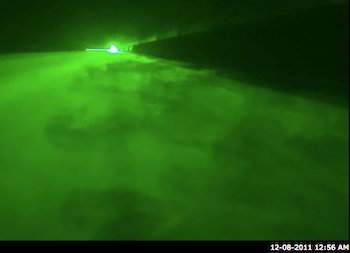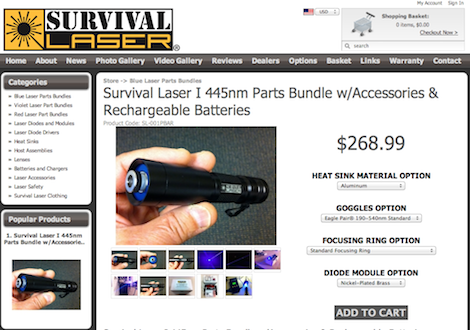Home
A comprehensive resource for safe and responsible laser use
World: Hobbyist injures self with 1 watt blue laser
(UPDATE March 14 2012: The hobbyist reported “I still have the blind spot, and was effectively told by the ophthalmologist that it would probably be there the rest of my life. That doesn't bother me TOO much, since it isn't very inhibiting.”)
.
How the injury occurred
The hobbyist’s laser was on a chair, creating a “liquid sky” effect. This involves having the beam scan or expand into a line, in order to illuminate a thin cross-section of smoke or fog.

Two days after the injury, the hobbyist posted a photo of the “liquid sky” effect. From his Dec. 8 post: “And just to show that I'm not going to let a little something like blindness in one eye keep me down, I finished the contraption that started this whole mess, except this time using a <100mW greenie instead.”
The laser fell off the chair. As it fell, the beam hit the hobbyist for “about 1 second” in his right eye. He experienced a dark red blur in the center of his vision. There was no pain. (This is to be expected, at least initially, since the retina has no pain receptors.)
Initial medical treatment
After a few hours with no improvement in vision, he posted his experience to the website LaserPointerForums.com. A number of persons advised him to immediately seek medical attention.
The hobbyist took their advice and drove to an emergency room. “Driving with one eye was a new experience in itself,” he stated. He waited five hours for a doctor, who told him to go to an “eye foundation hospital”. He did so.
At the eye foundation hospital, a retina specialist said the loss of vision was due to blood covering the retina, and it could clear up within a month or so. Here is a photo of the hobbyist’s injury:

Photo of the hobbyist’s retina, with blood covering the center of the retina.
Day 2
The next afternoon (day 2) there was “a bit” more vision in the affected spot, though vision was still blurry and orange-tinged.
Day 8
The hobbyist had an unspecified surgery on December 14. He said the doctor thought the injury “should clear up pretty good…. I was told the eye would be useless for the first few weeks, so I'm not expecting much.”
Day 10
On December 16, he wrote: “Vision is much improved, i no longer have a dark circle in the center vision, however it is very blurry - but that is expected this soon after surgery. I do have a small blind spot that is slightly off-center, but the doctor said my brain should auto correct it over time, but I will probably always have that blind spot to some degree.”
The hobbyist listed three lessons learned:
- Don’ use lasers over 5 milliwatts without proper safety glasses.
- Don’t put a laser on an unstable surface.
- If you have [or suspect] an eye injury, see a retina specialist. Emergency room doctors do not have the specialized training required (in the hobbyist’s view).
About the laser
The hobbyist’s laser used a nominal 1 watt, 445 nm diode. This is the same type that has been harvested from Casio “Green Slim” video projectors. This diode is also used in commercial handheld lasers such as the Wicked Laser Spyder III Arctic, which gained worldwide attention as the first high-powered handheld when it was released in June 2010.
The hobbyist had purchased the laser one week before the injury. The seller was Survival Laser of Cedar City, Utah, which sells “parts and components that may be assembled to construct handheld, high power (up to 2,200mW) 405nm (violet), 445nm (blue) and 635-660nm (red) wavelength lasers that can be used for numerous practical, educational, survival, aquarium pest control, military, law enforcement and research applications.”

This 1 watt 445 nm laser bundle “include[s] complete illustrated instructions and safety precautions and can be assembled in 5-10 minutes with no soldering or special mechanical skills required. The only tool necessary is an Allen wrench…” A typical assembly instruction sheet is here.
Survival Laser’s website is careful to list precautions. They also distribute an information sheet developed by this website, LaserPointerSafety.com. Ironically, the first warning on our information sheet is “Do not get direct beam in eye -- Blindness hazard!”
Injury description from a thread at LaserPointerForum.com. Survival Laser information from their website. Thanks to Constable Jeffrey Sharp, Peel Regional Police, Ontario for bringing this to our attention.
Editorial commentary from LaserPointerSafety.com
Relatively low injury rate from Class 4 lasers
This is the second injury from a Class 4 (above 500 mW) 445 nm diode that we are aware of. In the first case, the person affected wrote that the spot was not noticeable and he has “ceased worrying about it.”
While injuries are always of concern, it should also be kept in mind that many thousands of these high-powered 445 nm diodes have been used in homebuilt and commercial handheld lasers. Class 4 lasers are universally considered to cause instant eye damage. Therefore, the fact that there have only been two (reported) cases out of thousands of lasers in use, is relatively good news. When affordable 1 watt laser diodes first came out in 2010, we at LaserPointerSafety.com felt that there would be many accidents. We are pleasantly surprised to have been proven wrong.
Keep in perspective that many consumer products cause widespread and/or significant harm. The pages Risks of laser pointers and U.S. CPSC laser pointer reports give an idea of the injury rates and severity for typical consumer products and for consumer lasers. In general, consumer laser injuries are less common and less severe than those of many other consumer products.
(The above information is independent of the question of restricting Class 4 laser use by the general public. That is a separate issue which probably hinges more on the rate of laser misuse against aircraft, than on the rate of eye injuries.)
Laser hobbyists provide valuable advice
The members of LaserPointerForums.com should be commended for their assistance to the hobbyist who was injured. A number of them insisted he see a doctor immediately. They also discussed the need for appropriately wearing safety glasses, and of course for securing the laser and knowing the beam path before energizing the laser.
One wrote: “Those individuals who choose not to use safety goggles and experience an eyesight damaging occurrence do so at their peril and should not be a negative reflection on the forum because of the overwhelming prevalence of safety related topic postings including the emphasis on using safety goggles.”
There were also proposals for additional information “stickies” and forums to promote safe laser use.
.